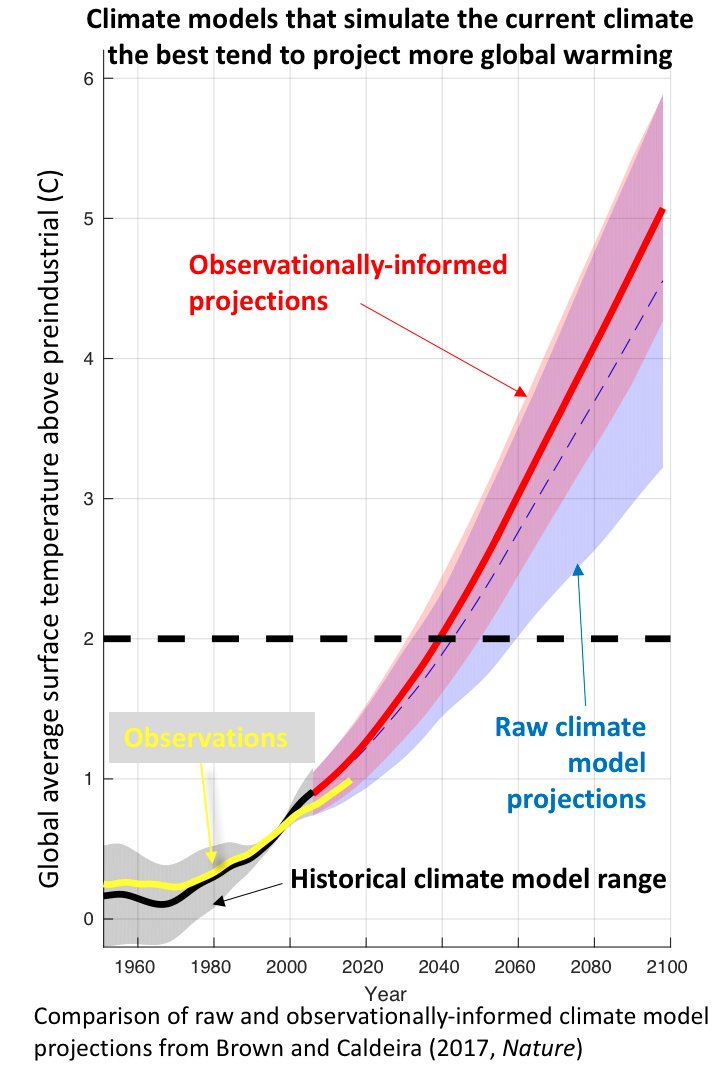New fit from climate change modeling groups is alarming.
Some of you may have seen a spate of articles in the last month about revisions to existing global warming models. If you haven't here is a short list:1) The ice sheets are melting faster [1]
2) The marine ice cliff instability [2] (the link here will take you to a site where you can hear expert opinions about an article about the marine ice cliff instability. This is a good link to have handy when discussing informed skepticism of climate change literature).
3) Revised rates from Brown and Caldiera [3]
There are many other articles that came out during the last round of climate change negotiations in Bonn [4]. (A lot of people dismiss those articles are being part of the negotiations posturing but I don't know if that is the correct way to think about it).
I want to focus on the Brown and Caldiera data. They started off building a model that would better match recent historical data and when they succeeded, they found it predicts a much faster global warming. This graph above summarizes their results.
There are several interesting parts to this but you can see that the point of crossing 2C (black dashed line crosses red solid line v/s black dashed line crosses light blue dashed line) has moved closer by about 5 years. The "Observationally informed model" is the new prediction (red solid line) and the "Raw climate model" is the older blue dashed line.
While it is important to remember that no model of climate phenomena can capture new emergent physics, it is equally important to note that a better fit to recent historical data is much more likely to capture the ongoing critical dynamics.
Let me put this another way.
We can crudely track two things - carbon energy consumption patterns and global temperatures. These two pieces of information are correlated in a general sense - we know that as we burn more carbon energy, we expect to see more GHG emissions and we throw off the balance between heat absorbed and radiated by the earth. That in turn raises global temperatures. We do not have an exact model for how that will happen and to top that off we know our measurements of both these data sets have errors in them.
In order to understand the relationship between these two imperfectly measured quantities we need models that cross-correlate them. There are a range of models used by the IPCC to cross correlate the global energy budget with the global temperature shift. These are collectively called RCP.
The number after the RCP (such as RCP4.5) denotes the extent to which the energy budget mis-matches due to rising GHG emissions. Ideally the earth would absorb and re-radiate the same amount of heat as it did in pre-industrial times, but we can model the effect of an imbalance to that heat balance. These RCPs capture those kinds of imbalances.
The most heat imbalanced model is RCP 8.5 (that is what is shown as the blue in that above graph). The issue that is repeatedly raised by people is that RCP 8.5 doesn't match recent observations. This is an accurate statement. Saying this is also a veiled way of saying that model does not appear to be perfectly capturing all the relevant physics.
What Brown and Caldiera are saying is that - if you make a model (red line) that better fits recent data, then you see a massive rise above RCP 8.5. The predictions become even more alarming.
Now there are two ways of reading this
1) The recent past represents some statistical fluctuations that correctly averaged by the RCP and we should not dismiss them on account of their inability to fit the recent data. This is the view proposed by Brown and Caldiera.
2) The models that return a better local fit also better capture present day dynamics (i.e. the REAL link between REAL carbon emissions and REAL global warming). This is the view that I find myself drawn to. I feel this is not some esoteric modelling community dissonance on the credibility of fit quality.
The problem in all this modeling has *always* been difficulties capturing emergent physics that creates feedback loops. When I saw the Brown and Caldiera article, the hair on the back of my neck stood up.
What if the RCP8.5 is wrong - and Brown and Caldiera have correctly captured an emergent physics that is driving global temperatures up at a much higher rate than IPCC estimates?
I understand the one would not want to rock the boat by saying things like that, but the boat may be able to hit an iceberg - and if rocking it a little bit like that - stops that from happening why not?


3 Comments:
the US is exporting LNG in a big way and its causing problems at the panama canal.
https://www.bloomberg.com/news/articles/2017-12-08/u-s-shale-has-a-panama-canal-problem-that-s-got-no-easy-fix
in 2016 the US was not exporting any LNG and now it is the worlds 3rd largest exporter. US capitalism is unbelievably a fast actor. not very good on long term planning but unbeatable for short term profit/projects.
if fusion power ever becomes practical it will go viral in and out of the US. at amazing speed.
I am still perplexed why solar power cannot be used to desalinate sea water on a vast scale for cities and deserts. is it that insanely expensive?
Post a Comment
<< Home